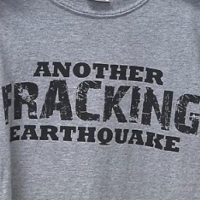Distant Earthquakes Linked to Problems at Fracking Sites in U.S.

There was an average of 21 earthquakes a year of magnitude 3.0 or higher in the central United States between 1967 and 2000. Between 2010 and 2012, that number grew to 200 a year, according to a study published in Science.
Researchers from Columbia University’s Earth Institute found that earthquakes in other parts of the world can have negative consequences in areas where the controversial oil and gas extraction process called hydraulic fracturing, or fracking, is used. The researchers analyzed existing quake data and found that faults near fracking sites exhibited high stress directly linked to earthquakes far away.
“The seismic waves act as the straw that breaks the camel's back, pushing the faults that last little bit toward an earthquake,” lead researcher Nicholas van der Elst wrote in an email to the Associated Press.
The study said there was a direct connection between a 9.0 earthquake in Japan in 2011 and a swarm of smaller quakes in a West Texas oil field that used fracking. A 4.1 quake near fracking wells in Prague, Oklahoma, was linked to an 8.8 quake in Chile in 2010. The Chile quake also shook the ground in Trinidad, Colorado, near natural gas fracking sites.
The earthquake threat doesn’t come from the hydraulic fracturing itself, but from the disposal of waste water and chemicals used in the fracking. It is these injection wells that have been linked to earthquakes.
A second study, also just published in Science, states that, “Microearthquakes (that is, those with magnitudes below 2) are routinely produced as part of the hydraulic fracturing (or ‘fracking’) process used to stimulate the production of oil, but the process as currently practiced appears to pose a low risk of inducing destructive earthquakes.”
However, the long-distance effect from major earthquakes could change the whole scientific and political dynamic surrounding fracking.
Fracking has been around for decades but is coming under increased scrutiny as California ponders tapping The Monterey Shale, a repository of oil that could top 15.3 billion barrels and may represent 60% of all shale oil in the country. It is pretty much unregulated in the state, while the energy industry fights rules that would force them to identify where they are fracking, give notice where they intend to frack and disclose what toxic chemicals they are pumping into the ground with millions of gallons of pressurized water.
Critics say fracking has been linked to groundwater contamination, air pollution, releases of methane gas, micro-earthquakes and sink holes. A 2011 report from the Committee on Energy and Commerce in the House of Representatives identified 29 known or suspected carcinogens used in fracking between 2005 and 2009.
-Ken Broder
To Learn More:
Study: Distant Quakes Can Affect Oil, Gas Fields (by Alicia Chang, Associated Press)
Fracking Linked to Earthquakes, Study Finds (Agence France-Presse)
Injection-Induced Earthquakes (by William L. Ellsworth, Science)
Enhanced Remote Earthquake Triggering at Fluid-Injection Sites in the Midwestern United States (by Nicholas J. van der Elst, Heather M. Savage, Katie M. Keranen and Geoffrey A. Abers, Science)
Federal Judge Blocks U.S. Drilling Leases that Ignored Dangers of Fracking (by Ken Broder, AllGov California)
Ohio Government Confirms Earthquakes Caused by Fracking-Related Injection Wells (by Matt Bewig, AllGov)
- Top Stories
- Unusual News
- Where is the Money Going?
- Controversies
- U.S. and the World
- Appointments and Resignations
- Latest News
- Musk and Trump Fire Members of Congress
- Trump Calls for Violent Street Demonstrations Against Himself
- Trump Changes Name of Republican Party
- The 2024 Election By the Numbers
- Bashar al-Assad—The Fall of a Rabid AntiSemite






Comments